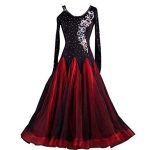A Dance Dress is the costume worn by a dancer when performing, which might or might not be custom designed for use in a specific dance work, or it may have a traditional design, such as those used in some ceremonial occasions, folk dances, festival dances or in movies. Typically, dance dresses are designed to harmonize with the dance and not hinder the movements.
These dresses are designed to expose or enhance the lines formed by the dancer’s body, to express the choreographer’s artistic vision, to engage the audience, or combinations of these. It may portray or relate to some characteristic, mood, or theme of the dance and are usually designed in accordance with dance type requirements, the anticipated movements of the dancer, and budget.
Salsa dance is a style where dancers shift their weight by stepping, while the upper body remains level and nearly unaffected by the weight changes. Weight shifts cause the hips to move and arm and shoulder movements are also incorporated. So salsa dancer’s males usually were a tight pant and shirt and girls were short and tight dresses which will not disturb them while dancing because dance involves significant movement above the waist, with up and down shoulder movements and shifting of the ribcage. If salsa dancers wear long gowns or full shoulder dress they may lots of difficulties with the fluid movements and might also trip while exchanging their places while dancing.
Ballet dancers usually wear a frock because ballet is a soft musical dance form where dancers dance on their toes and feet. They wear short to medium length frocks because while dancing ballet there are so many formations and rotations in dance, with few lifts
Each dance type is different from the other and thus every dance form requires a typical type of dance dress that is suitable for its particular movements, stage setting, music, place and audience.
 thefashiontamer.com Fashion Inspirations
thefashiontamer.com Fashion Inspirations














